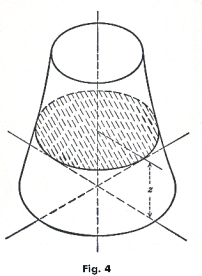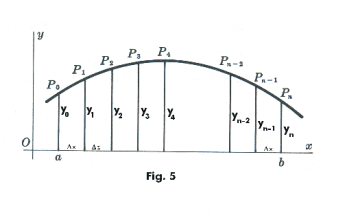Website owner: James Miller
APPROXIMATE INTEGRATION, TRAPEZOIDAL RULE, PRISMOIDAL FORMULA, SIMPSON’S RULE
Introduction. An approximate value of the integral
![]()
can be obtained by certain numerical formulas and by the use of mechanical integrators made for the purpose such as the polar planimeter. There are several reasons why one might choose to use one of these methods. Typically in practical work in science and engineering one is working with measured data that only has a certain accuracy. We are thus working with data that is approximate already. And the accuracy of the results can’t be expected, of course, to exceed that of the initial data. An approximating method may give an answer that is as accurate as we need. An approximating method may be the most practical. And in some cases we may be just unable to use regular integration. For example, often the integrand f(x) is defined by a table of values. Or the integral may not be expressible in terms of elementary functions. Or it might possibly be expressible in terms of elementary functions but just extremely difficult to integrate.
Often one of the various methods of approximate integration may indeed be just as good for our particular problem as regular integration and may be much easier and faster.

The trapezoidal rule. The trapezoid rule for approximating the value of the definite integral
![]()
is as follows:
Divide the interval from x = a to x = b into n equal subintervals of length Δx = (b - a)/n, erect ordinates y0, y1, y2, ... , yn as shown in Fig. 1, and join the tops of the ordinates by straight line segments. Then the sum of the areas of the trapezoids thus formed will be an approximation to the area under the curve. If we denote their sum by AT, then
AT = ½ (y0 + y1)Δx + ½ (y1 + y2)Δx + ...... + ½ (yn -1 + yn)Δx
or
1) AT = Δx[½ y0 + y1 + y2 + ......... + yn -1 + ½ yn].
The accuracy of the approximation will depend upon the number of intervals used and upon the character of the function f(x). If f(x) is given as a table it must be remembered that formula 1) may be applied if and only if the spacings between abscissa points are equal. If the spacings are unequal one must use the following formula:
2) AT = ½ (y0 + y1)Δx1 + ½ (y1 + y2)Δx2 + ...... + ½ (yn -1 + yn)Δxn
where Δxi = xi - xi -1.

Example. Evaluate approximately
![]()
taking n = 5.
Solution. We divide the interval from x = 0 to x = 2.5 into 5 equal parts where the length of each part is Δx = 0.5. The following table gives the computed ordinates.

The trapezoidal formula then gives:
A = 0.5[ ½ (4) + 3.98 + 3.87 + 3.55 + 2.83 + ½ (0.61)] = 8.27.
See Fig. 2.
The prismoidal formula. The prismoidal formula for approximating the value of a definite integral is given in following theorem:
Theorem 1. If f(x) is a polynomial of degree 3 or less, then
![]()
In this equation f(a), of course, represents
the value of the integrand when x = a, f(b) is
its value when x = b, and
![]() is its
value when the value of x is half-way
between a and b.
is its
value when the value of x is half-way
between a and b.

The geometrical interpretation is given by Fig. 3. Assuming that f(x) is a polynomial of degree 3 or less, then the area under the curve y = f(x) in the interval from x = a to x = b is given exactly by the formula
![]()
If f(x) is not a polynomial in x or if it is not of degree 3 or less, then 4) gives an approximation to the area by giving exactly the area under the parabola
y = Ax2 + Bx + C
that passes through the points P, Q and R (Fig. 3). It may be remarked that the area under any cubic curve through P, Q, and R, in the interval from x = a to x = b, is equal to that under the parabola.
Example. Evaluate
![]()
using the prismoidal formula.
Solution. The values of the function 3x - ⅓x2 when x = 1, 3, and 5 are respectively 8/3, 6, and 20/3. Consequently,
![]()
History of prismoidal formula. The prismoidal formula originated as an expression for the volume of any solid (such as prismoids and prismatoids) which may be suitably decomposed into prisms and related solids such as pyramids and frustums of pyramids. The prismoidal formula for the volume of any of these solids is
![]()

where A1 and A3 are the areas of the bases whose distance apart is h, and A2 is the area of the cross-section of the solid in a plane parallel to the end planes and halfway between them.
This prismoidal formula 5) is a direct consequence of Theorem 1. Let the area of the cross section of the solid shown in Fig. 4, at a distance z above its base, be A(z). Then if the height of the solid is h, its volume is given by
![]()
If A(z) is a polynomial in z of degree 3 or less, then the value of this integral is, by Theorem 1,
![]()
where A1, A2, and A3 denote the areas at the bottom, mid-section, and top, respectively.
The prismoidal formula 5) does in fact give the exact volume of a prismatoid, prismoid, prism, pyramid, frustum of a pyramid, wedge, cylinder, cone, frustum of a cone, sphere, ellipsoid, spherical segment, or, in general, any solid bounded by a quadric surface and two parallel planes. For in all these cases it may be shown that the area of the cross-section in any intermediate plane parallel to the end planes is a quadratic function of x.
For solids not satisfying the specified conditions, the prismoidal formula gives an approximation to the volume. The formula can be used with a fair degree of accuracy for almost any solid whose surface does not have sudden and extensive breaks and irregularities. If the surface is irregular it may be possible to divide the solid up into portions which approximate figures for which the formula holds. The formula is extensively used in earthwork and masonry computations. Engineers use it, for example, in estimating the volumes of such irregular solids as are encountered in making cuts and fills in road building.
Simpson’s Rule. 1. Divide the interval from x = a to x = b into n equal subintervals of length Δx = (b - a)/n where n must be an even number. 2. Erect ordinates y0, y1, y2, ... , yn as shown in Fig. 5. Simpson’s Rule states
![]()

where the number of intervals must be even.
Simpson’s Rule is obtained by using the prismoidal formula to approximate the area under each of the arcs P0P1P2, P2P3P4, ...., Pn-2Pn-1Pn and then adding together the results. Thus
![]()
or
![]()
From previous considerations it is clear that this formula will give the value of the integral exactly if f(x) is a polynomial in x of degree not higher than 3.
References.
Middlemiss. Differential and Integral Calculus.
Smith, Salkover, Justice. Calculus
Oakley. The Calculus.
Jesus Christ and His Teachings
Way of enlightenment, wisdom, and understanding
America, a corrupt, depraved, shameless country
On integrity and the lack of it
The test of a person's Christianity is what he is
Ninety five percent of the problems that most people have come from personal foolishness
Liberalism, socialism and the modern welfare state
The desire to harm, a motivation for conduct
On Self-sufficient Country Living, Homesteading
Topically Arranged Proverbs, Precepts, Quotations. Common Sayings. Poor Richard's Almanac.
Theory on the Formation of Character
People are like radio tuners --- they pick out and listen to one wavelength and ignore the rest
Cause of Character Traits --- According to Aristotle
We are what we eat --- living under the discipline of a diet
Avoiding problems and trouble in life
Role of habit in formation of character
Personal attributes of the true Christian
What determines a person's character?
Love of God and love of virtue are closely united
Intellectual disparities among people and the power in good habits
Tools of Satan. Tactics and Tricks used by the Devil.
The Natural Way -- The Unnatural Way
Wisdom, Reason and Virtue are closely related
Knowledge is one thing, wisdom is another
My views on Christianity in America
The most important thing in life is understanding
We are all examples --- for good or for bad
Television --- spiritual poison
The Prime Mover that decides "What We Are"
Where do our outlooks, attitudes and values come from?
Sin is serious business. The punishment for it is real. Hell is real.
Self-imposed discipline and regimentation
Achieving happiness in life --- a matter of the right strategies
Self-control, self-restraint, self-discipline basic to so much in life